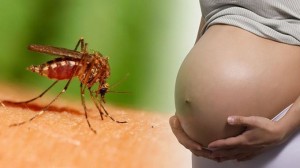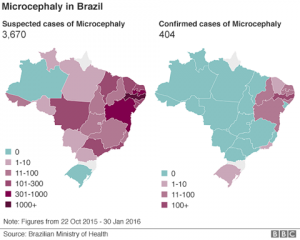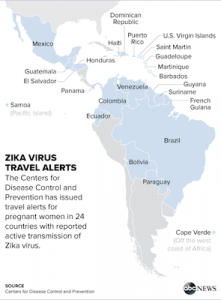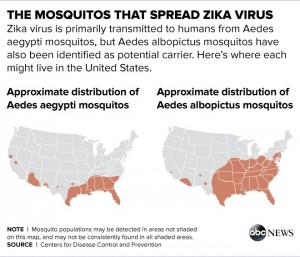
Everyone has heard about the Zika virus. That wasn’t the case a couple of years ago, especially in the US. The Zika virus is a flavivirus which is transmitted by various tropical mosquitos. Other viruses from the genus flaviviridae include west nile and dengue virus. Why has there been so much recent hype about the Zika virus when it has been identified since 1947? Previously, the infection was thought to be benign, just a rash and fever lasting a few days, and even no symptoms at all in 80% of the cases. Over the years there have been a couple of outbreaks in various parts of the world but there was minimal buzz. Why is this outbreak different? Approximately 7-8 months after the height of this latest outbreak was identified in Brazil in early 2015, children were born with neural defects such as microcephaly (small head) at alarming rates. Cases of microcephaly in Brazil went from 200 per year to around 4000 suspected cases in 2015 following the Zika outbreak. This warranted the World Health Organization (WHO) to declare a “Public Health Emergency of International Concern”.

Now the WHO and the Center of Disease Control and Prevention (CDC) have declared both the infections of Zika virus and the cases of microcephaly both epidemics in Brazil. Both organizations hesitated, at first, to link the Zika virus to the increase of microcephaly cases. There was no definitive proof that the virus caused this birth defect. It has taken about 6 months since the uptick of microcephalic births in Brazil for the CDC to confirm a correlation between Zika virus infections and these specific birth defects. Caution was taken not to jump to any conclusions without scientific evidence, even though the writing was on the wall.

So why did it take so long for these experts to confirm a link between the virus and the microcephaly cases? The scientific evidence used is based on a set of rules called Shepard’s criteria for proof of human teratogenicity (causing birth defects). This criteria is based on seven conditions in which at least three must be met. One of the conditions met by Zika virus is the timing of exposure for the pregnant women, the first trimester, when brain development is known to occur in the fetus. Many of these Brazilian babies born in October of 2015 had brain development occurring, in utero, during the height of the Zika outbreak in March of 2015. It is also known that other viruses cause some of these same defects at this critical time in the brains development, during the first and second trimester. Other conditions pointing towards a connection relate to the rarity of the infection and the rarity of the birth defect. This is seen in cases where the mother is exposed during travel to infected areas during her first trimester and this birth defect occurs back home where both the infection and defect are rare. Scientist do not have the data from previous studies or animal testing to present the research evidence linking the virus to the defect so they rely on this criteria to confirm the correlation.
With this new declaration, warnings on travel and exposure during pregnancy can be fully supported. Also suggested by the CDC and WHO is delaying pregnancy if exposure is possible. More research must be conducted including testing of the expectant mothers for infection and corresponding ultrasound or amniocentesis. Not only should pregnant women avoid these infected areas, they should practice safe sex with those who have travelled to these areas.

The type of mosquito which carries the Zika virus is found in the southern continental US and a similar type of mosquito has been thought to be capable of carrying the virus and it is found in further north. So far there have been no cases of Zika virus infections in the US from a mosquito bite except in Puerto Rico. Transmission through sex with someone who has travelled to an infected country has been identified in the US.

The CDC has an up to date website with Zika virus statistics for the US including cases from travel or sexually transmitted infections. There is also a description of symptoms, maps of the outbreak, prevention measures and the latest new updates. WWW.CDC.gov/zika/index.html
The bottom line is avoid mosquito bites, avoid travel to effected areas if pregnant or considering pregnancy, practice safe sex if pregnant or consider delaying pregnancy if your partner has been in the effected area. Even though the Zika virus is merely a fever, rash and some other annoying symptoms for most, it can be spread by a mosquito bite and can have a devastating effect on an unborn child.
References
Al-Qahtani, A. A., Nazir, N., Al-Anazi, M. R., Rubino, S., & Al-Ahdal, M. N. (2016). Zika virus: a new pandemic threat. Journal Of Infection In Developing Countries, 10(3), 201-207. doi:10.3855/jidc.8350
Fellner, C. (2016). Zika Virus: Anatomy of a Global Health Crisis. P & T: A Peer-Reviewed Journal For Formulary Management, 41(4), 242-253.
Rasmussen, S .A., Jamieson, D. J., Honein, M. A., & Peterson, L. R. (2016). Zika Virus and Birth Defects — Reviewing the Evidence for Causality [Special report]. The New England Journal of Medicine. DOI: 10.1056/NEJMsr1604338
